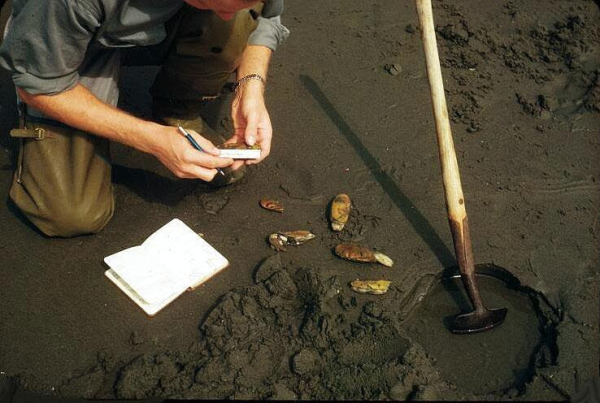OLYMPIA - Razor clam diggers can return to ocean beaches for a seven-day opening beginning Dec. 10.
State shellfish managers with the Washington Department of Fish and Wildlife (WDFW) approved the dig on evening low tides after marine toxin tests showed the clams are safe to eat.
The approved dig is for the following beaches, dates and low tides:
- December 10, Tuesday, 5:28 pm, -0.2 feet; Long Beach, Twin Harbors, Mocrocks
- December 11, Wednesday, 6:06 pm, -0.6 feet; Long Beach, Twin Harbors, Copalis
- December 12, Thursday, 6:45 pm, -0.9 feet; Long Beach, Twin Harbors, Mocrocks
- December 13, Friday, 7:26 pm, -1.0 feet; Long Beach, Twin Harbors, Copalis
- December 14, Saturday, 8:08 pm, -1.0 feet; Long Beach, Twin Harbors, Mocrocks
- December 15, Sunday, 8:53 pm, -0.8 feet; Long Beach, Twin Harbors, Copalis
- December 16, Monday, 9:41 pm, -0.4 feet; Long Beach, Twin Harbors, Mocrocks
No digging is allowed before noon for allowed digs, when low tide occurs in the evening.
"We also were able to pencil out tentative dates, and upcoming digs bring a ton of opportunity to harvest clams well into the new year," said Dan Ayres, WDFW coastal shellfish manager.
In order to ensure conservation of clams for future generations, WDFW sets tentative razor clam seasons that are based on the results from an annual coast-wide razor clam stock assessment and by considering harvest to date. WDFW authorizes each dig independently after getting the results of marine toxin testing.
Proposed razor clam digs for Long Beach, Twin Harbors, Copalis and Mocrocks include:
- December 23, Monday, 4:35 pm, -0.4 feet; Long Beach, Twin Harbors, Mocrocks
- December 26, Thursday, 6:47 pm, -1.1 feet; Long Beach, Twin Harbors, Copalis
- December 27, Friday, 7:26 pm, -0.9 feet; Long Beach, Twin Harbors, Mocrocks
- December 28, Saturday, 8:05 pm, -0.6 feet; Long Beach, Twin Harbors, Copalis
- December 29, Sunday, 8:43 pm, -0.2 feet; Long Beach, Twin Harbors, Mocrocks
- January 8, Wednesday, 5:05 pm -0.3 feet; Long Beach, Twin Harbors, Mocrocks
- January 9, Thursday, 5:47 pm -0.8 feet; Long Beach, Twin Harbors, Copalis
- January 10, Friday, 6:29 pm -1.2 feet; Long Beach, Twin Harbors, Mocrocks
- January 11, Saturday, 7:11 pm -1.4 feet; Long Beach, Twin Harbors, Copalis
- January 12, Sunday, 7:53 pm -1.3 feet; Long Beach, Twin Harbors, Mocrocks
- January 13, Monday, 8:36 pm -1.2 feet; Long Beach, Twin Harbors, Copalis
- January 14, Tuesday, 9:20 pm -0.5 feet; Long Beach, Twin Harbors, Mocrocks
- January 21, Tuesday, 4:23 pm -0.1 feet; Long Beach, Twin Harbors, Mocrocks
- January 22, Wednesday, 5:10 pm -0.5 feet; Long Beach, Twin Harbors, Copalis
- January 23, Thursday, 5:53 pm -0.6 feet; Long Beach, Twin Harbors, Mocrocks
- January 24, Friday, 6:32 pm -0.6 feet; Long Beach, Twin Harbors, Copalis
- January 25, Saturday, 7:08 pm -0.5 feet; Long Beach, Twin Harbors, Mocrocks
- January 26, Sunday, 7:42 pm -0.3 feet; Long Beach, Twin Harbors, Copalis
- February 6, Thursday, 4:40 pm -0.3 feet; Long Beach, Twin Harbors, Mocrocks
- February 7, Friday, 5:26 pm -0.9 feet; Long Beach, Twin Harbors, Copalis
- February 8, Saturday, 6:09 pm -1.3 feet; Long Beach, Twin Harbors, Mocrocks
- February 9, Sunday, 6:51 pm -1.4 feet; Long Beach, Twin Harbors, Copalis
- February 10, Monday, 7:32 pm -1.3 feet; Long Beach, Twin Harbors, Mocrocks
- February 11, Tuesday, 8:13 pm -0.8 feet; Long Beach, Twin Harbors, Copalis
- February 12, Wednesday, 8:55 pm -0.1 feet; Long Beach, Twin Harbors, Mocrocks
- February 20, Thursday, 4:54 pm 0.0 feet; Long Beach, Twin Harbors, Copalis
- February 21, Friday, 5:35 pm -0.1 feet; Long Beach, Twin Harbors, Mocrocks
- February 22, Saturday, 6:11 pm -0.2 feet; Long Beach, Twin Harbors, Copalis
- February 23, Sunday, 6:44 pm -0.1 feet; Long Beach, Twin Harbors, Mocrocks
Final approval of the tentatively scheduled openings will depend on whether results of marine toxin tests show the clams are safe to eat.
Ayres notes that low tides around New Years are not low enough for successful razor clam harvest, so digging will not open then.
WDFW is also asking razor clam fans around the state to weigh in on the perennial question: Which is better, clam gun or shovel? To register support for a favored digging method, clam diggers can post a photo or video, complete with hashtag #TeamClamShovel or #TeamClamGun on any social media before the end of the spring season.
Additional safety considerations are important this time of year. "Diggers want to be sure to come prepared with good lighting devices and always keep an eye on the surf, particularly at this time of year when low tides come at dusk and after dark," said Ayres.
All diggers age 15 or older must have an applicable 2019-20 fishing license to harvest razor clams on any beach. Licenses, ranging from a three-day razor clam license to an annual combination fishing license, are available on WDFW's website at https://fishhunt.dfw.wa.gov and from license vendors around the state.
Under state law, diggers at open beaches can take 15 razor clams per day and are required to keep the first 15 they dig. Each digger's clams must be kept in a separate container.
WDFW is the state agency tasked with preserving, protecting and perpetuating fish, wildlife and ecosystems, while providing sustainable fishing, hunting and other outdoor recreation opportunities.
